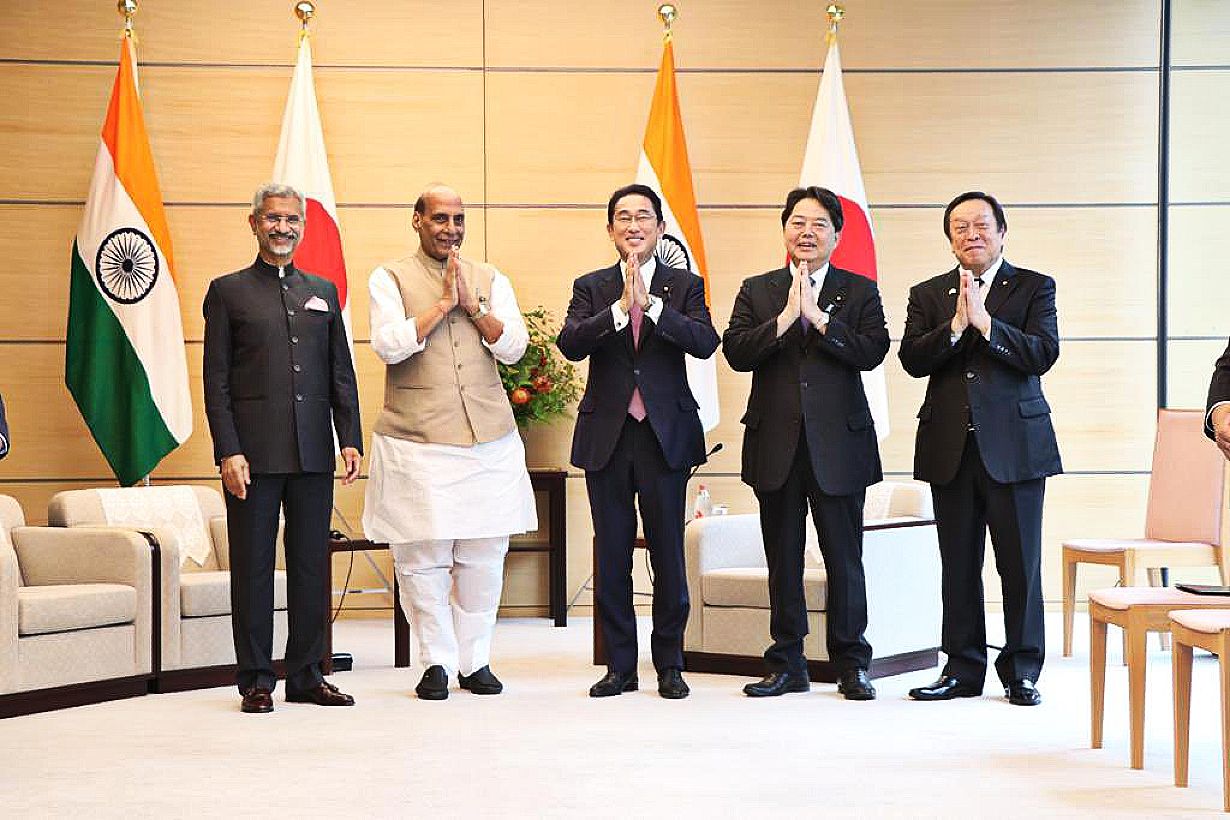Asian NATO: Why India Does Not Back Japan’s Idea Despite Tensions With China & Alliance With Tokyo?

On September 27, Shigeru Ishiba emerged victorious in a runoff against top female candidate Sanae Takaichi to become the head of the ruling Liberal Democratic Party (LDP) in Japan.
As a result, on October 01, Ishiba took over as prime minister of Japan from Fumio Kishida following his official election by the Japanese parliament. Ishiba stands for an attempt to change the LDP. If you vote for him, it indicates that the LDP is committed to fostering a reform-oriented image. If a non-conformist, non-faction leader is elected, the LDP should be stronger for the elections that take place next month.
Known for his defense expertise, Ishiba is likely to continue many of the policies of his predecessor, Prime Minister Fumio Kishida. However, it is also widely anticipated that he will seek methods to strengthen Japan’s independence while appreciating the importance of the American alliance.
Some of these strategies include renegotiating the Status of Forces Agreement and exploring collective security agreements with like-minded allies in Asia.
The inauguration of Shigeru Ishiba as prime minister ushers in a new era for the nation’s military tactics and foreign policy. In an article he wrote for the Hudson Institute in Washington, Ishiba advocated for a conversation on the potential for American nuclear weapons to be stationed in the Asia-Pacific region (APR) and the establishment of an Asian counterpart to NATO.
This project not only changes the course of Japanese policy but also questions the country’s remilitarization and what it means for the rest of the region.
Japan followed a pacifist posture outlined in its Constitution for many years. But shifting political dynamics worldwide and escalating hostilities in the area—particularly in light of China’s expanding military might and North Korea’s nuclear aspirations—are pressuring Japan to reevaluate its defense policies.
Shigeru Ishiba, a well-known supporter of bolstering Japan’s defense capabilities, has drawn attention to the absence of an Asia-Pacific collective defense framework that is NATO-equivalent and capable of successfully thwarting threats from nations such as China, Russia, and North Korea.
Ishiba explicitly suggested in his statement that an alliance be formed in Asia to coordinate operations with the United States and maybe employ nuclear weapons as a deterrent. This action represents a significant shift from Japan’s “nuclear-free” posture adopted after the war. Tokyo has long refrained from making official commitments to nuclear weapons, even in spite of its close defense ties to the United States.
However, Japan’s objectives have changed as a result of North Korea’s nuclear ambitions and China’s growing military activities, notably near the disputed Senkaku Islands.
China has been acting more aggressively in the South China Sea and surrounding the Senkaku Islands, which Japan claims as its own. The increased level of tension makes Japan more dependent on security assurances and ways to stave off possible attacks.
In the meantime, China and Russia maintain their military cooperation by deepening their strategic partnership and holding cooperative drills. In this situation, Ishiba suggested an Asian alliance modeled after NATO.
The countries in the region will have no choice but to look for measures to safeguard their interests if China and Russia maintain their tight coordination. It is believed that Ishiba’s idea is a reaction to these altering global dynamics. Recently, for the first time, Chinese warships sailed into Japanese waters while Chinese aircraft flew over Japanese airspace. In response, Japan sent its own warships—for the first time—into the Taiwan Straits.
Apart from maintaining nuclear deterrence, Japan is proactively improving its military capabilities and fortifying its alliance with the United States armed forces. One of the biggest military exercises, with 45,000 soldiers, is called “Keen Sword-25,” and it is slated for the fall of 2024. These drills show Japan’s preparedness to incorporate military activities into its civilian domain by utilizing civilian infrastructure like ports and airports.
AfriPrime App link: FREE to download...
Tokyo is trying to move away from its long-standing pacifist position, which restricted the use of its military forces to self-defense, as these moves indicate. Although Japan adheres to a Constitution that outlaws war as a way of resolving international conflicts, its current activities demonstrate increased confidence in the need for active deterrence.

Positioning India
PM Ishiba’s proposal to form an Asian NATO includes India as well. Additionally, he recommended that the region either build its own nuclear weapons or that the US station nuclear weapons there.
This proposal results from the growing Chinese threat, especially regarding Taiwan, and doubts about the US extended deterrent’s dependability.
As tensions rise, India will need to strike a balance between its strategic autonomy and the security interests of its close partners without getting embroiled in a formal mutual defense pact.
Ishiba hasn’t traveled to India on business. For most of this century, when India-Japan relations grew under Shinzo Abe, he was not part of the mainstream LDP. At the G20 and East Asia summits, Ishiba would meet the leaders of ASEAN and the Quad, which included Australia and India.
Naturally, Japan’s top focus continues to be its deepening and intensifying alliance with the US. Unlike its more junior partner status in the past, Japan is today a global partner with a growing defense role.
Under the US nuclear umbrella, Japan had placed sanctions on India for its 1998 nuclear tests; today, it is considering a future in which it may require nuclear weapons. With a developing fleet of ship-based submersible ballistic nuclear submarines (SSBNs) and intercontinental ballistic missiles (ICBMs), India is a nuclear weapons state.
India’s security is not dependent on the US nuclear umbrella. This is the exact reason India should not join an Asian NATO, especially if it is motivated by concerns over Taiwan. A mutual defense commitment will be going too far, even if India has strategic alliances, reciprocal logistics agreements, joint military exercises, and enhanced interoperability with the Quad countries.
India’s external affairs minister, S. Jaishankar, recently said that India didn’t share the vision for an ‘Asian NATO’ proposed by Japanese Prime Minister Shigeru Ishiba. Jaishankar was speaking at the Carnegie Endowment for International Peace in Washington when he said that, unlike Japan, India had never been a treaty ally of another country.
When asked about Japan’s call for a NATO-like grouping of Asian countries, Jaishankar said, “We don’t have that kind of strategic architecture in mind.” India, Japan, Australia, and the US are part of the Quad, deemed a counterbalance to China.
The idea put up by Ishiba to station nuclear weapons in the Asia-Pacific area will undoubtedly spark fresh hostilities. China and Russia will probably interpret this action as a threat to their security and take appropriate action diplomatically or militarily. It’s unlikely that North Korea will overlook any discussion of increased American nuclear deterrent in the area.
India and Japan have been strong allies for many years. They share the goal of an open and free Indo-Pacific, have growing economic and defense ties, and are dedicated to regional stability.
Although China’s assertiveness and Japan’s growing security worries are legitimate, India must proceed cautiously with the suggested solution—an Asian NATO. Remilitarization, the creation of an Asian NATO, and nuclear weapons may be considered necessary responses to escalating threats.
However, there are still unanswered concerns about how these choices will affect Japanese society and the stability of the Asia-Pacific area in the long run. If an Asian NATO is established, India will need to collaborate closely but will not join it.
India’s involvement in the Indo-Pacific is already important, and its participation in organizations like the Quad provides a framework for coordination on regional security without the rigidity of a formal military alliance.
AfriPrime App link: FREE to download...
https://www.amazon.com/Africircle-AfriPrime/dp/B0D2M3F2JT
- Questions and Answers
- Opinion
- Story/Motivational/Inspiring
- Technology
- Art
- Causes
- Crafts
- Dance
- Drinks
- Film/Movie
- Fitness
- Food
- Giochi
- Gardening
- Health
- Home
- Literature
- Music
- Networking
- Altre informazioni
- Party
- Religion
- Shopping
- Sports
- Theater
- Wellness
- News
- Culture
- War machines and policy

